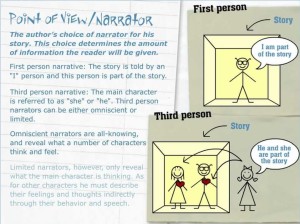Clarify the difference between single and multiple viewpoints.
 Before you start writing your story, it’s important to clarify in your own mind the difference between single and multiple viewpoints.
Before you start writing your story, it’s important to clarify in your own mind the difference between single and multiple viewpoints.
A tale told from a single point of view is when you only tell the story from one person’s perspective. Everything is filtered through that person’s eyes, heart, and mind. No other character’s thoughts or feelings are directly expressed in the book. This does not mean, however, that you can’t show how others feel through their actions and reactions to people, places, and events.
In a book with multiple points of view, the stories are told through the eyes, heart, and minds of two or more characters. There are times when a narrative demands such treatment to convey the fullness of the story. You can create multiple points of view in the first or third person. The choice is up to you.
When writing for children, it’s usually best to maintain a unity of point of view. Younger children, especially, become confused if you change points of view in the middle of a story. Once you settle on your point of view, stick to it.
To determine the points of view of your story, you must ask yourself two critical questions: who is telling the story, and how is it told?
Who do I want to tell the story to?
The writer’s task is to choose the most effective character or characters to tell the tale.
How do I want to tell the story?
Do you tell the story in first person (I did this, and I saw that) or third person (she did this, and she did that)?
To determine how you want to tell your story, it’s critical to familiarize yourself with the range of choices available and the advantages and disadvantages of each choice.
Advantages of first person point of view
In a first-person story, the narrator is the “I” of the story. Everything that happens in the book is told from a singular point of view.
One person is telling the story—especially children like to read books written in the first person. If the voice is strong and the character interesting, kids easily relate to a hero who speaks directly to them. Readers enjoy getting into the head of someone they don’t know.
Writers new to storytelling often choose the first person because that’s how they wrote all their lives in letters and journals.
When you write a story in the first person, your ability to shift from place to place and person to person is limited. Everything you write about must be witnessed by the narrator; you can only observe. You cannot assume anyone thinks or feels anything unless it is manifested in some overt way. Every scene is written from the first-person narrator’s singular point of view.
Obviously, your plot development options are limited when you can’t report on anything that takes place out of sight of the narrator. You also run the risk of sounding repetitive in your writing. There’s no doubt that too many “is” can become tedious.
Advantages of first-person
You can create a sense of connection. The intimacy of first-person sets up a direct connection between reader and writer.
The reader experiences the intensity of a personal story. Can the sense that the story is being told just to them, as if someone is whispering secrets from the pages of a book.
You can create an intimate portrait. Readers feel close to the action and the hero. It’s easy to slip your imagination into the mind and heart of the first-person narrator.
You can create a variety of moods. You can create the mood of your choice by using a singular voice. You can write in the voice of a tough kid on the voice of a dreamy romantic. It all depends on the story you want to tell and the feelings you want to convey.
Disadvantages of first-person
Your story is limited to one point of view. Since your story cannot expand beyond what the narrator thinks, sees and hears, no action can take place out of sight of the first-person narrator.
The narrator can, however, interpret reactions. “Michael looked worried when his mother asked me about the money,” or “Dan’s voice shook when he told me what happened.”
Closeness the story can diminish perceptions. The point of view character is too close to the action, you might not have the perspective to tell an interesting story.
Beware of dangerous is. Too many “is” can small your pros and bore the reader.
First-person moods
The first person narration works at all age levels. Early chapter books readers enjoy it just as much as teenagers. One of the pleasures of writing in first-person is that you can create such a variety of moods. Serious and funny, casual and formal, angry and gentle. It’s all there for you to explore.
Third person, single point of view.
In the third person, single point of view, you tell the story using “he said, she said” dialog tags. But you still confirm the action to one person’s thoughts, feelings and point of view.
In a way, this is an expanded version of the first–person narration. The “I” becomes “he” or a “she.” You still can’t get in anyone else’s head or witness an action outside the knowledge of this particular character. You stay with a single, designated character, telling the story exclusively from his single, designated viewpoint.
Advantages of a third person, single point of view
The reader identifies with a specific character. As in first-person, this technique enlist the reader’s allegiance and invites a strong emotional identification with one specific character.
Your narrative horizons are expanded. This shift in perspective is not as limited as you might imagine, not as restrictive as some people would have you believe. Here, you can devise one voice for the protagonist and a different one for the narrator, giving you the latitude to play voice and tone against each other.
For instance, if the narrator of the story is an angry kid, but the tone of the book – the story being told – is magical and mournful, the interplay between these different moods can create and in treating and memorable story.
Here, as in first-person, you can create a narrative shift to another location by having the character imagine a distant scenario.
Your ability to offer emotional insight is deepened. Some people believe telling your story from this point of view diminishes your ability to evoke the hero’s feelings, thoughts, and passions. Not so. It’s just as easy to get into a character’s head in third-person narration as in first-person narration.
Your opportunity to interpret events is enlarged. The narrator and the viewpoint character can comment on events, allowing the author greater latitude in opening doors to understanding.
The disadvantage of a third-person single point of view.
Your viewpoint is limited to one character. As in first-person, you can only tell your story through one character’s eyes.
It’s hard to balance the narration. It’s a great challenge to balance the author’s voice with a third person, a single voice that views the events.
Start against the advantages of this point of view. However, I don’t view these drawbacks as inhibiting.
Debunking the myth
You can still get into a character’s head and heart and mine the depth of the feelings the character experiences. To accomplish this, you must remain more conscious of showing (not telling) how the character feels.
A perspective frequently used in children’s literature, the third person, single point of view, is an intriguing way to tell a story, especially if you want to focus on the event in one character’s life. Depending on the author’s voice and the protagonist’s mood, you can create the same variety of feelings as you can in first-person, evoking either complementary or contradictory moods as you do it.
Third person, limited point of view
In the third person, limited point of view, the author tells the story in the third person (he said, she said) but from more than one point of view. If you want to focus on two of three characters, this is the narrative approach you would choose.
However, exploring hidden places requires more effort and maintaining the bond between the character and the reader. But you can achieve this by entering the character’s thoughts and showing his actions and reactions to various circumstances.
Advantages of a third person, limited point of view
You can convey a fuller story. Instead of telling the story from just one point of view, this method allows you to expand your horizons and witness other events without losing the tight focus on two or three main characters.
You can get into the head of more than one character. Instead of being limited to the thoughts and feelings of a single character, you can deepen insight into the emotional state of several characters, thereby deepening the reader’s appreciation of the events and dilemmas you present.
You have a better chance of reader identification. This approach allows for a strong identification between the reader and more than one character.
If you have several characters who play essential roles in the plot, the reader can experience the thoughts and feelings of all these characters. This increases the understanding of the conflict and allows the writer to state the case from more than one person’s point of view.
You can create a conflict in the reader’s mind. If you paint full portraits of two or three characters, you can then set of questions for the reader to consider. Who is writing this situation? Which path would I choose? How would I behave here? Even though identify with this character, I can understand that one. Feelings like this keep the reader interested in the story since he wants to know how the conflict will be resolved and which character will be proven right.
It’s easy to paint the world in shades of gray. By the time they reach the third and fourth grades, most kids are beginning to suspect they don’t live in a black-and-white world.
Yet the children expect a world with solid distinctions between good and evil. All the children understand that this is not the way the world works. They also appreciate the opportunity to read stories portraying life as more complex and realistic.
Disadvantages of a third person, limited point of view.
You must pay special attention to delineating your voices. If you switch between several points of view, it’s critical to be clear about who is speaking in which scene and who is witnessing each event. The reader should never have to pause and figure out who is the point of view is being expressed.
Third person, omniscient point of view.
An omniscient point of view means that the author knows everything. Stories are told from an omniscient point of view of the multiple ways of looking at a given incident. If five people witnessed one incident, the author could express how each feels. The author assumes a godlike position, looking down from the mountain and narrating what he sees below.
The omniscient point of view it’s been used as frequently as the other approaches to storytelling. Even though this technique allows the author of the most incredible range, it is fraught with pitfalls. Unless this approach is executed with consummate skill, the omniscient point of view can weaken the story, and I moved the reader’s allegiance to any single character. Furthermore, the omniscient voice can be confusing to young readers.
That said, if your goal is to get into the head of lots of characters, this is the point of view for you.

